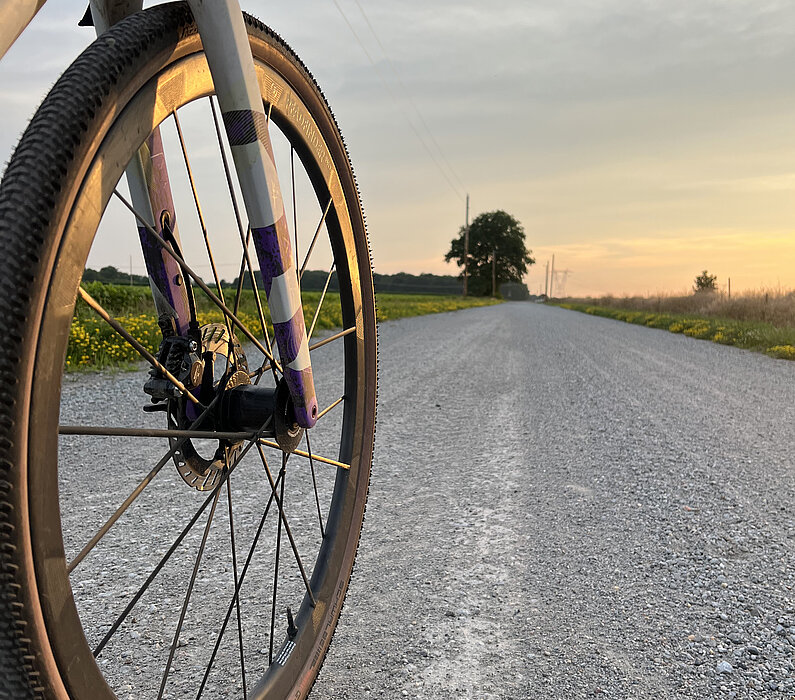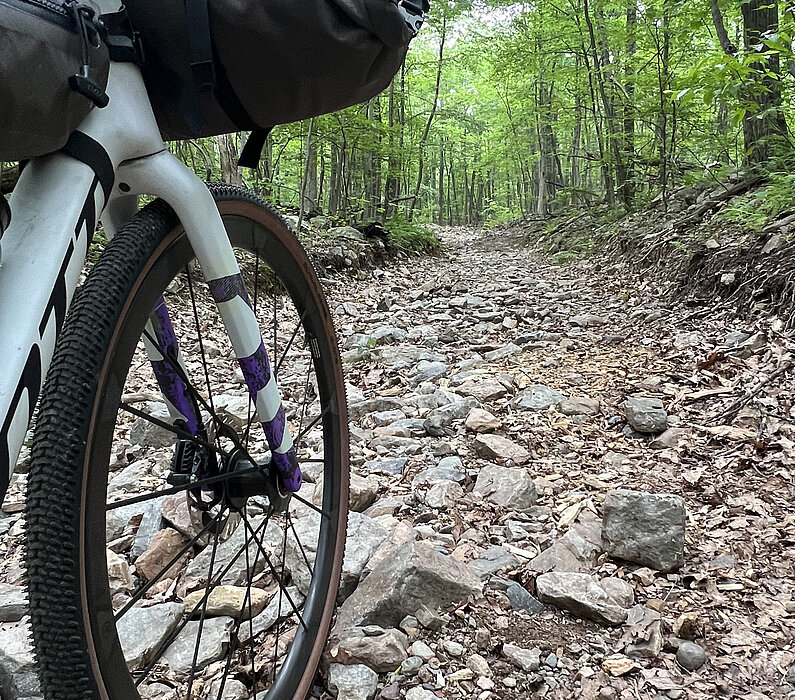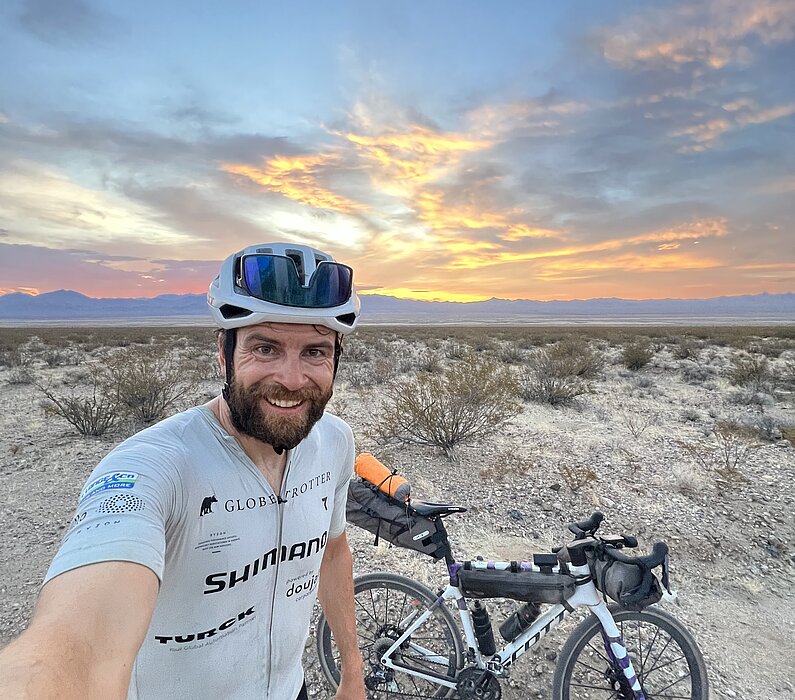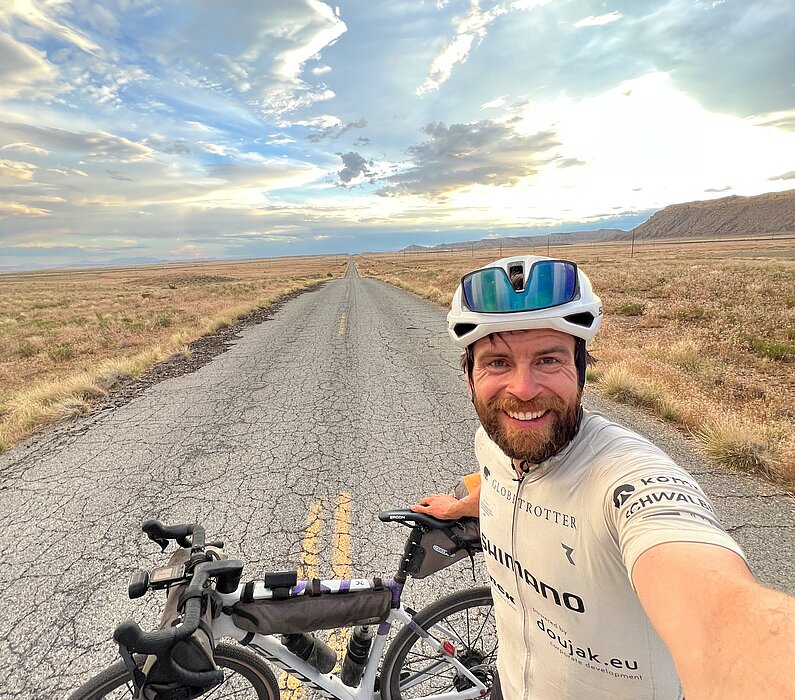Photo by @Markus_Weinburg
Interview with Jonas Deichmann
Two Ways to Cross the US with Jonas Deichmann
Jonas Deichmann is many things. He’s a cyclist, a runner, and a swimmer. He’s also a speaker and author—not to mention a multi-time world record holder. Included in all of that, perhaps the characteristic that best defines Jonas is this: unstoppable. Currently on another of his many adventures, Jonas is crossing the United States twice, once by bike and once by foot in a duathlon of epic proportions, all while raising money for a cause near and dear to his heart. We caught up with Jonas shortly after he’d completed the cycling leg of his journey, chatting with him from a hotel on the outskirts of the Mojave Desert as he rested following a long day in the heat on his feet.
Can you tell me about your current adventure?
It’s TransAmerica twice. I cycled from New York to Los Angeles on a gravel bike, so I didn’t take the fastest possible route, but a nice one with some climbing and some gravel roads. It was like 5,400 kilometers. I arrived after 25 days to Los Angeles last week. And now I’m running back.
25 days—is that what you estimated the cycling portion would take, or were there any surprises along the way?
It was pretty much what I estimated. I had made a time sketch of the whole thing, so I had to push through. I was going against the wind the entire time.
Almost everybody goes west to east, and there is a reason for that. I would say maybe 80% of the time, I was fighting a headwind.
And the heat around where I am now, in Utah then Nevada, and especially in California in the Mojave Desert—I have cycled across the Sahara before and in the Australian Outback in summer—but this is worse. This is way worse. It’s something I underestimated a bit. It’s been a massive challenge.
Photo by @Romanshotthis
How did this idea first start?
Two and a half years ago, I completed a triathlon around the world. That was 120 times the Iron Man distance. During that challenge, I had originally wanted to run across the US. But it was during the pandemic, and the embassies were closed—and I had been in Iran and Sudan—so I couldn’t just enter the US. I needed to get a business visa, and it didn’t work out. I couldn’t get into Canada either, so I ended up running across Mexico. It was super nice, but there was still a bit of unfinished business.
Since Cycling is my favorite discipline, I didn’t want to come back just to run across the US. I wanted to do something that involved cycling. So,
I thought, “Why not do it twice—cycling across, then running back?” So, that’s what I’m doing now.
Photo by @Markus_Weinburg
Is this your first big adventure in the US?
No, I do have the world record for cycling from Alaska to Argentina, so I passed through before. I went through a little bit east of the Rocky Mountains.
So, did you cross paths with your previous route on this trip?
Of course! The last time I was going from north to south; now I’m doing from east to west. I passed my old path in Fort Collins, Colorado. Also, to train for the Pan-America back in 2018, I traveled for four months by bike around the western part of the US, in Arizona up to Montana to Oregon, Washington, down through California. But I had never traveled coast to coast.
And this is super interesting. Everyone who travels to the US usually goes to either the east or west coasts. In the middle, there’s just a lot of nothing.


Photos by @Jonas_Deichmann
How do you stay fueled when you’re on the road, especially in those large areas of nothingness?
Yes, that’s a big challenge. I have to eat enough. I already lost quite a bit of weight during the cycling leg. I eat all the time on the bike. I have snacks that I find in shops or gas stations. A lot of gas stations have pizza. I also go to restaurants, or I cook my own food. In the western part, it’s easier because you have a lot of Mexican restaurants, which are very nice. But in the small towns in the Midwest, it’s just junk food. They have nothing that’s even slightly healthy.
What’s more difficult, the cycling or running portion?
Definitely the running. It’s way more difficult. With cycling, it’s less stress on the body. And with cycling, if you climb up a mountain, then you get to go down. If you ride into a headwind, eventually you will have a tailwind, for a day or two at least. You get to recover. But running downhill or running with a tailwind, it still isn’t easy. It’s way more demanding.
On the other side, I averaged like 220km per day on a gravel bike, so you go like all day long. If you do any stops, there’s very little time for anything else. But with running, take now for example, it’s 5pm and I’m already done with my day. There’s a bit more free time.
Photo by @Markus_Weinburg
During the cycling portion, what was your schedule like?
I’d usually ride from sunrise to sunset, but I had to change that a bit when I got to the very hot areas, Nevada and the Mojave Desert. There,
I started way before sunrise to escape the heat. One day, it was 46° Celsius. At noon, cycling was almost impossible.
Do you plan your destination for the end of each day, or do you just see how far you can make it and stop accordingly?
It’s a bit different, depending on whether I’m cycling or running. With cycling, I have a bigger travel radius, and I like camping, so I might find a nice town for dinner, then I’ll cycle out after and pitch my tent somewhere. When I’m running, I want to be as close as possible to my 50km goal at the end of each day. If I run 40, that’s not okay. That’s definitely not enough. Running 60, that’s a big burden on the body, so I want to be close to 50km.
That means I have to plan ahead. Where can I sleep? Where will I find food? In the US, it’s not always easy to find places for camping, especially in the Midwest where every square centimeter of the country is privatized with a big fence and “no trespassing” signs—sometimes a flag from the National Rifle Association. You have to be a bit careful about pitching your tent there. That makes it more challenging to find a nice spot.
Photo by @Markus_Weinburg
That leads well into my next question: how have the people you’ve met along your journey treated you?
I have some followers here in the US, and many have even come out to meet me along the way. They either cycled for a bit with me or gave me some snacks or drinks for the road. But that stopped after Colorado. In Southern Utah, Nevada, and California, no one cycles that time of the year. So, since Colorado, I’ve not seen any supporters. It’s just too hot for the people.
On the running leg, I had maybe 30 people run with me out of Los Angeles. And since then, every day someone has joined me for a bit.
It’s nice. I expect to see more people once I’m out of the desert again, of course.
Photo by @Jonas_Deichmann
Do you have a favorite region that you’ve traveled through so far?
Utah. I love Utah. It’s just so bizarre, the landscape. Colorado is super nice, also, as are many other places. But Utah has something I’ve never seen anywhere else in the world.
How did you choose the route that you’re following?
I planned it using Komoot and Google, a combination of both. Now, I’m running a bit further south than I cycled, a different route. It’s not the fastest route, but I also don’t want to spend a year traveling, so it’s a combination of speed and nice scenery. Through the Midwest, I mostly took a more direct route because there aren’t that many highlights, to be honest. When I reached the Rocky Mountains, I took more detours. It was super nice.
But take Nebraska, for example. I just wanted to get out as fast as possible because it’s so boring.
Are there any records you’re aiming to break on this adventure, or is this more of a personal journey?
Before, my past journeys were always about some kind of record. For this one, as far as I know, no one has done an unsupported duathlon across the US, so it will be a first. But it’s not my main priority. I will do it very quickly. When I ran across Mexico, I averaged 44km per day; now I’m averaging 50. So,
you may argue that it’s some kind of record, but that’s not the main focus of my project. I want to enjoy the journey.
How has this compared in terms of difficulty to your past projects?
The triathlon around the world was definitely—from a logistics standpoint and with the swimming and running or being on the bike in Siberia in winter—more challenging. But I have to say, the US is super tough mentally. In the middle, there’s just cornfields. There’s nothing. You can go straight for like 1,000km and there’s nothing. Mentally, it’s one of the toughest times ever.
And then there’s the heat—the heat is insane here in Nevada.
Photo by @Markus_Weinburg
Besides the heat, have you come across any more wild weather on this journey?
I’ve had super strong headwinds, of course. I also came into a storm on the prairies. It was something I’d never seen before. It was in Nebraska. There was low wind and nice weather, then suddenly the sky was black, and a thunderstorm started. But it was short—less than ten minutes and it was over. But the wind was so strong, I struggled to keep the bike straight. There was big hail, and that really hurt. I had marks on my arms everywhere where the hail had hit me. And there was lightning super close. It was a bit scary. I’d never seen a thunderstorm like that before. In Europe, we don’t have that—not like this.
And right now, three days ahead of me, there’s a big wildfire, so I’m changing my route. I expect that the smoke will most likely affect me. Already, in Las Vegas, they have health warnings, and I will be much closer to the fires than Las Vegas.


Photos by @Jonas_Deichmann
How do you pass the time each day when you’re running or riding?
I listen to music and podcasts; that does help a bit. I also think about life and the world, plan my next adventures. I think about the kilometer ahead. I think about food a lot. And like that, time passes.
What keeps you going during the hardest times?
It’s an adventure, so I know that the hard moments are part of it—and usually make the best memories afterwards.
I wouldn’t change that for anything. It’s my big passion, and that’s a part of it. It’s not always nice and easy.
I focus on the small goals—the next kilometer, I have to get to the next gas station and then I get an ice cream and then I continue. And some day, I’ll be done!
Photo by @Markus_Weinburg
Do you have any sort of celebration each evening when you reach your daily destination?
I like to eat something very nice. Here, that’s often an ice cream and some tacos or enchiladas if I can find them. But I always like to eat something very nice at the end of each day.
How often are you camping versus staying in hotels, and do you have a preference? Is staying in a hotel a reward?
I would say it’s about 80% camping. And no, a hotel isn’t a reward. I enjoy camping at least equally, depending on where I am. A hotel might be comfortable, but in a hotel, nothing exciting will happen. Last night, I camped in the Mojave Desert. That was super nice. But sometimes, a hotel is nice to be able to recharge the batteries on everything or to jump in the pool.
Photo by @Romanshotthis
How do you plan your kit list? It must be difficult to choose what you’ll bring and what you won’t.
I have a lot of experience with this from my past adventures.
It’s always a balance of comfort, reliability, and speed. And usually for me, comfort loses because I want to be fast.
So, I go very lightweight. There’s nothing in my gear that I don’t need. It’s very light, and it’s also very reliable.
The worst thing that can happen for me is to have something break down—even worse if it’s something very specific that you can’t find any replacement for. On the bike, I check everything to see if there’s anything that could break and mean game over. With a derailleur hanger, for example, that’s something that’s usually specific to the bike, so I carry a spare. But I won’t carry a spare chain because I can just get one somewhere else.
Speaking of equipment, how have the Lightweight wheels been on your journey?
They’ve been fantastic. From my cycling gear, that’s the one thing most people ask me about. “Why do you cycle across the country with full carbon wheels?”
I’ve been with Lightweight now for over two years, and I’ve simply never had a problem.
The wheels are fast. They’re super nice to ride. And as long as you don’t crash or have something come in from the side, they’re not going to break. And I don’t crash.
I’ve done zero maintenance on them since I got them two years ago, and I’ve had zero issues.
Can you tell me about the organization you’re riding for?
I ride for World Bicycle Relief. It’s a charity that gives bikes to children and healthcare workers in rural Africa. There, sometimes schools can be 20 or 30km away. With a bike, kids can just cycle there, so they have a bigger radius for travel. Also, bikes are environmentally friendly, it’s just the best thing in life. So, we’re raising money and hope that a lot of people can get a bike.
Photo by @Markus_Weinburg
What’s next on this journey?
Well, the real remote desert starts now, so I’ll have about 250km of Mojave Desert ahead of me. And then, I’ll be getting into Utah soon, which will be very, very nice. Then it’s Colorado with some nice climbing. I have some passes around the Durango area. That will also be nice. And after that, it’s cornfields.
You can follow Jonas’ journey on Instagram @jonas_deichmann or help support his fundraiser through the link below: